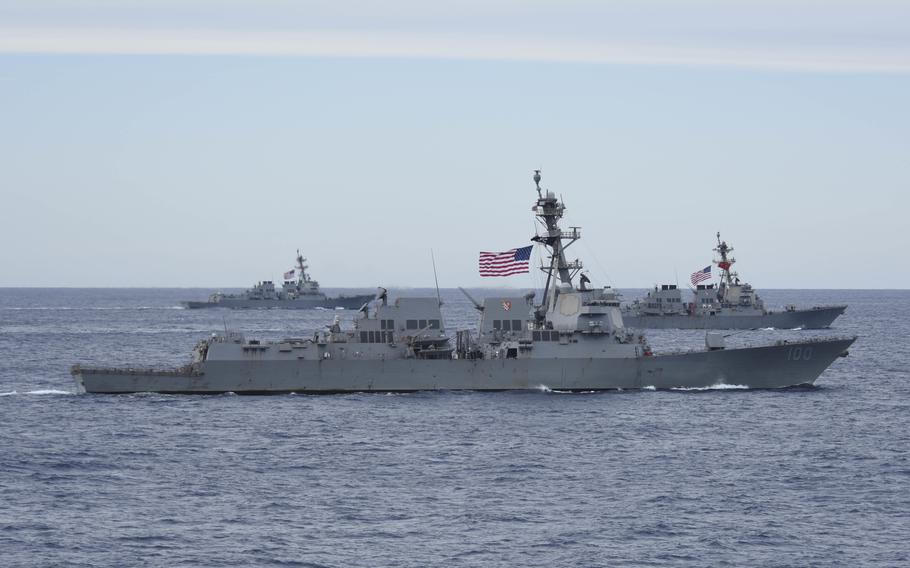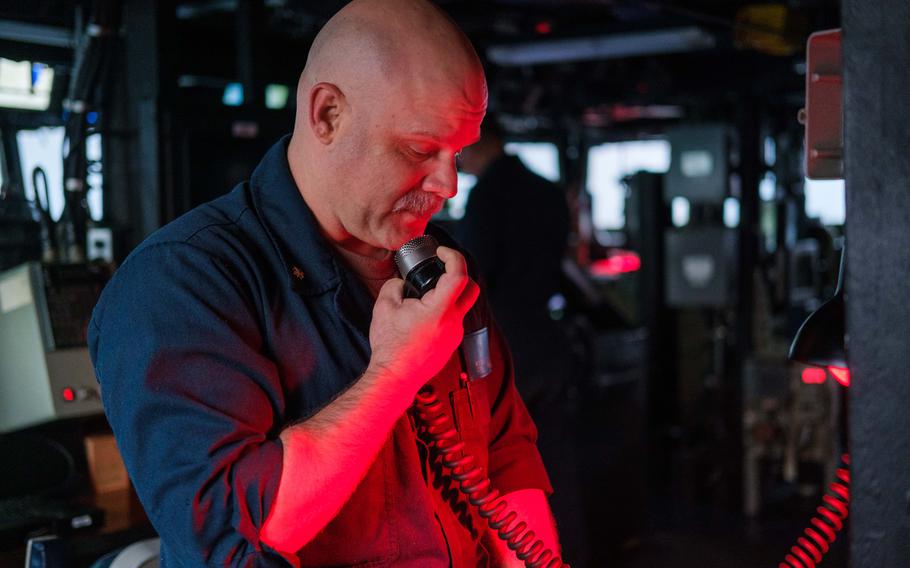.jpg/alternates/LANDSCAPE_910/8549097%201.jpg)
Lt. Sarah Gomez-Lorraine, chaplain of the Arleigh Burke-class, guided-missile destroyer USS Spruance, holds Sunday service on the mess decks on July 21, 2024. (Mass Communication Spc. Seaman Joey Sitter/U.S. Navy)
WASHINGTON — The Navy is poised to meet its goal of having a chaplain serving aboard each of its destroyers by 2025, culminating a yearslong effort to have dedicated emotional and spiritual counselors aboard the warships to help sailors battle the struggles that can arise during long missions at sea.
The service set a goal in 2023 to assign one chaplain per destroyer by 2025 in hopes of filling a shortage of emotional, mental and spiritual counselors aboard those ships. The goal meant creating 48 new permanent billets.
As of September, the Navy had a dedicated chaplain serving aboard 29 of 31 East Coast-based destroyers and 27 of 45 West Coast-based destroyers, leaving 20 billets to be created in the coming year.
“But they will all be filled in fiscal year 2025. That is when the funding comes online for the unfilled billets,” said Rear Adm. Gregory Todd, chief of the U.S. Navy Chaplain Corps.
The Navy began focusing on mental health resources and quality-of-life initiatives in 2022 after a spate of 10 suicides and at least two suicide attempts aboard the aircraft carriers USS Ronald Reagan, USS Theodore Roosevelt and USS George Washington. The service documented 71 suicides in 2022 and another 69 suicides in 2023, according to the Defense Suicide Prevention Office.
While the Navy Chaplain Corps already has permanent positions aboard larger vessels such as aircraft carriers, amphibious assault ships and guided-missile cruisers, chaplains have historically supported destroyers at the squadron level, with two assigned to accommodate multiple warships spread across an area of responsibility. The difference between a squadron level chaplain and a dedicated destroyer chaplain, Todd said, is all about accessibility.
“If you have two chaplains per squadron, they are always a visitor,” he said. “They are somebody that is not part of the crew, not part of the ebb and flow of the ship’s life.”

The Arleigh Burke-class, guided-missile destroyers USS Kidd, USS Howard and USS Shoup participate in a group sail in 2017 in the Pacific Ocean. (Mass Communication Spc. 2nd Class Ian D. Zagrocki/U.S. Navy)
Putting a chaplain onboard a ship full time, Todd said, fosters better relationships between the chaplains and the crew. Chaplains serve as religious advisers and routinely assist sailors with operational stress, family problems and coping with life at sea.
A dedicated chaplain was aboard each East Coast-based destroyer that deployed to the Middle East in the past year as the Israel-Hamas conflict reached a boiling point and Iranian proxy forces launched relentless attacks on merchant shipping vessels in the Red Sea. Conversations between those chaplains and their crews included the sensitive nature of combat, Todd said.
“There were issues like, ‘Oh my goodness, what I am doing has a potential of taking another person’s life’ — in firing missiles at enemy combatants. So, how do we work through that?” Todd said.
In 2023, destroyers with a chaplain on board averaged 31 counseling sessions per month, compared to just three per month for those without chaplains. That data has held consistent throughout the process to place more chaplains aboard destroyers, Todd said.
To meet sailors where they were, destroyer chaplains go to the combat center of the ship, where missiles are fired. Since January, U.S. Central Command, which oversees military operations in the Middle East, has reported almost daily instances of U.S. forces destroying attack drones, land-based missile systems and enemy support vehicles.
“Having those kinds of important conversations along the way are encouraging and helps people have a sense of meaning to what they’re doing,” Todd said. “Do you count that as a counseling appointment? Probably not, but it is an important engagement.”
Now that the Navy is nearing the finish line of assigning a chaplain to every destroyer, Todd said, the service has its eye on frigates, as well as adding more chaplain billets for the Marine Corps and Coast Guard, both of which fall under the Navy Chaplain Corps. The service is also exploring ways to recruit chaplains from within its ranks.
The service has prioritized at-sea billets in recent years, assigning more chaplains to ships. Doing so, Todd said, came with the risk of leaving shore-based billets empty. In September 2021, the Navy had 886 billets with 877 chaplains on active duty. As of August, the number of billets had increased to 932 while the number of chaplains held steady at 877. A comparison of shore-based billet vacancies was not available, the Navy said.

A chaplain aboard the Arleigh Burke-class, guided-missile destroyer USS Mason conducts evening prayer for the crew on March 4, 2024. (U.S. Navy)
“We need to recruit more — that is the challenge right now,” Todd said.
The Chaplain Corps is aiming to recruit 100 new chaplains in the coming year.
To become a Navy chaplain, an individual must have a master’s degree or equivalent and be endorsed by a religious institution. Once selected, the candidate must pass the Navy’s physical fitness test and complete officer development school and chaplain school, which take about eight weeks.
While there is still work to be done, Todd said, putting chaplains closer to the deck plate has given the Chaplain Corps a sense of what drives service members — “feeling like they are doing something important.”
“That’s kind of a spiritual thing — to sacrifice for the greater good, to really be part of something bigger than themselves,” he said. “That is why they joined [the military].”